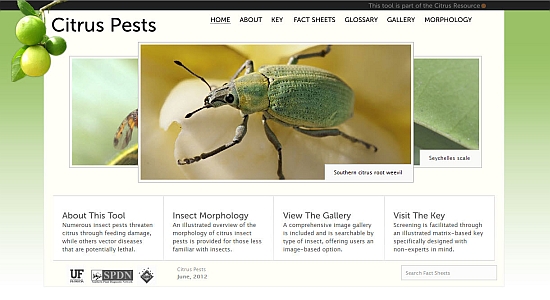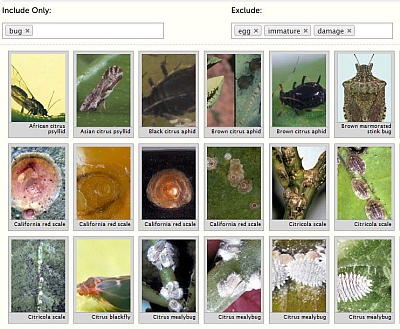Citrus Pests LUCID Key
Authors: Sarahlynne Guerrero, Jennifer Weeks, Amanda Hodges, Kirk Martin, and Norman Leppla
CPHST’s Identification Technology Program is pleased to announce the release of the final Citrus Resource tool, Citrus Pests. Developed through collaboration among CPHST, University of Florida, and Southern Plant Diagnostic Network, Citrus Pests offers screening support for over 50 important insect pests of citrus. Citrus Pests is aimed primarily at extension agents, inspectors, and other plant professionals with access to a light microscope and hand lens. It is designed to help users determine which type of citrus insect pest they have encountered by featuring an interactive key coupled with illustrated, descriptive fact sheets for each pest. Citrus Pests also offers users a wide variety of other resources to aid inexperienced users in the identification of insect pests of citrus, including a comprehensive image gallery that can be filtered by insect type or life stage, an insect morphology tutorial, and a detailed glossary.

Citrus Resource now offers users a comprehensive identification resource for citrus commodity surveys. The resource was created to provide growers, the industry, and those associated with citrus pest and disease detection an easily accessible site to assist with their identification needs. Citrus Resource includes three stand-alone tools to support citrus commodity surveys: Citrus Pests, a symptom-based tool for diseases (Citrus Diseases), and one for over 500 citrus cultivars grown in the United States (Citrus ID). Each tool includes an interactive matrix-based key, fact sheets, an image gallery, and other pages designed with the user in mind. Citrus Resource links directly to all three tools, offers instant access to each tool’s filterable image gallery, and includes background information about citrus as a commodity in the United States.
 A morphology tutorial is included in the many features designed to assist the non-expert user in screening insect pests of citrus. These pages show examples of winged and wingless insects, identify the three insect body regions, and give specific examples of a number of different head, thorax, leg, wing, and abdominal features that can be used to help identify the many different types of insects that are included in the tool. Each thumbnail can be expanded to show a large size image, allowing you to quickly find more detail on any particular structure. Shown at left is a screenshot of the leg feature page, showing diagrams of insect legs and leg parts, how to count tarsomeres, and examples of different hind leg shapes.
A morphology tutorial is included in the many features designed to assist the non-expert user in screening insect pests of citrus. These pages show examples of winged and wingless insects, identify the three insect body regions, and give specific examples of a number of different head, thorax, leg, wing, and abdominal features that can be used to help identify the many different types of insects that are included in the tool. Each thumbnail can be expanded to show a large size image, allowing you to quickly find more detail on any particular structure. Shown at left is a screenshot of the leg feature page, showing diagrams of insect legs and leg parts, how to count tarsomeres, and examples of different hind leg shapes.
 The tool also includes a comprehensive filterable image gallery. You can choose to look only at images of any of the insect orders included in the tool, only certain life stages, or combine the two. Shown at right is a screenshot of the image gallery with filters chosen to view only adult Hemiptera (true bugs, scales, aphids, psyllids, etc.).
The tool also includes a comprehensive filterable image gallery. You can choose to look only at images of any of the insect orders included in the tool, only certain life stages, or combine the two. Shown at right is a screenshot of the image gallery with filters chosen to view only adult Hemiptera (true bugs, scales, aphids, psyllids, etc.).
The interactive key in the tool is specifically designed with non-experts in mind, with simplified terms to make it easier to use. The fact sheets use entomological terminology for scientific accuracy, but you can easily find definitions for glossary terms by hovering your mouse over highlighted words. The fact sheets are also searchable from anywhere in the tool, allowing you to quickly find information on any of the pests in the tool.
The developers of Citrus Pests would appreciate receiving any comments about the tool’s value and usefulness and learning of any problems you encounter when accessing or using the tool. Please contact Amanda Hodges (email achodges@ufl.edu) with any comments or questions about tool content, or Amanda Redford (email amanda.j.redford@aphis.usda.gov) with accessibility, functionality, or other website issues.
For more information about other CPHST identification resources and tools for plant protection and quarantine, contact Amanda Redford. To find other identification aids for tortricids, visit ID Source - citrus insects. To view other identification tools developed by the CPHST ITP team, visit ID Source - ITP.
